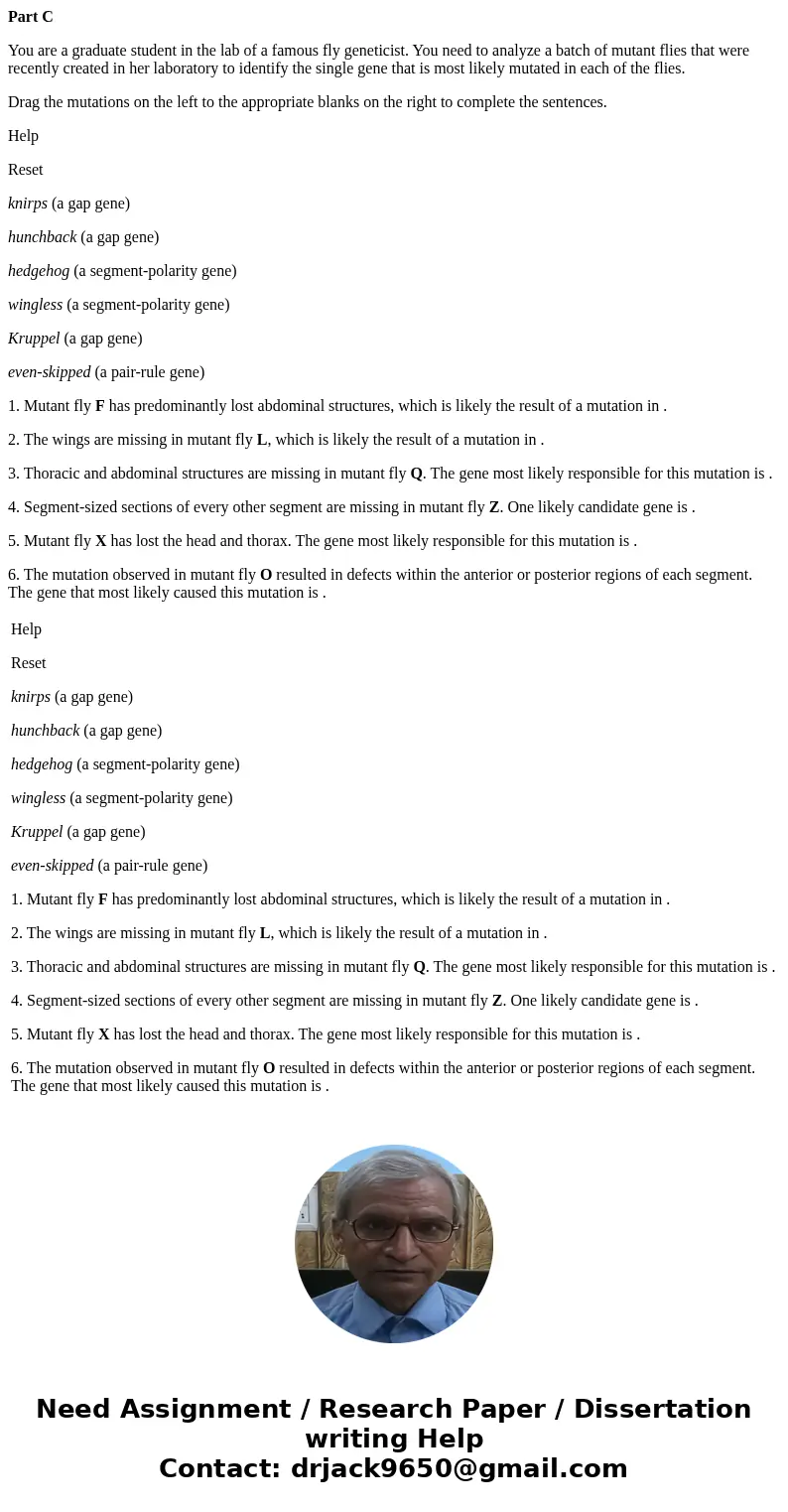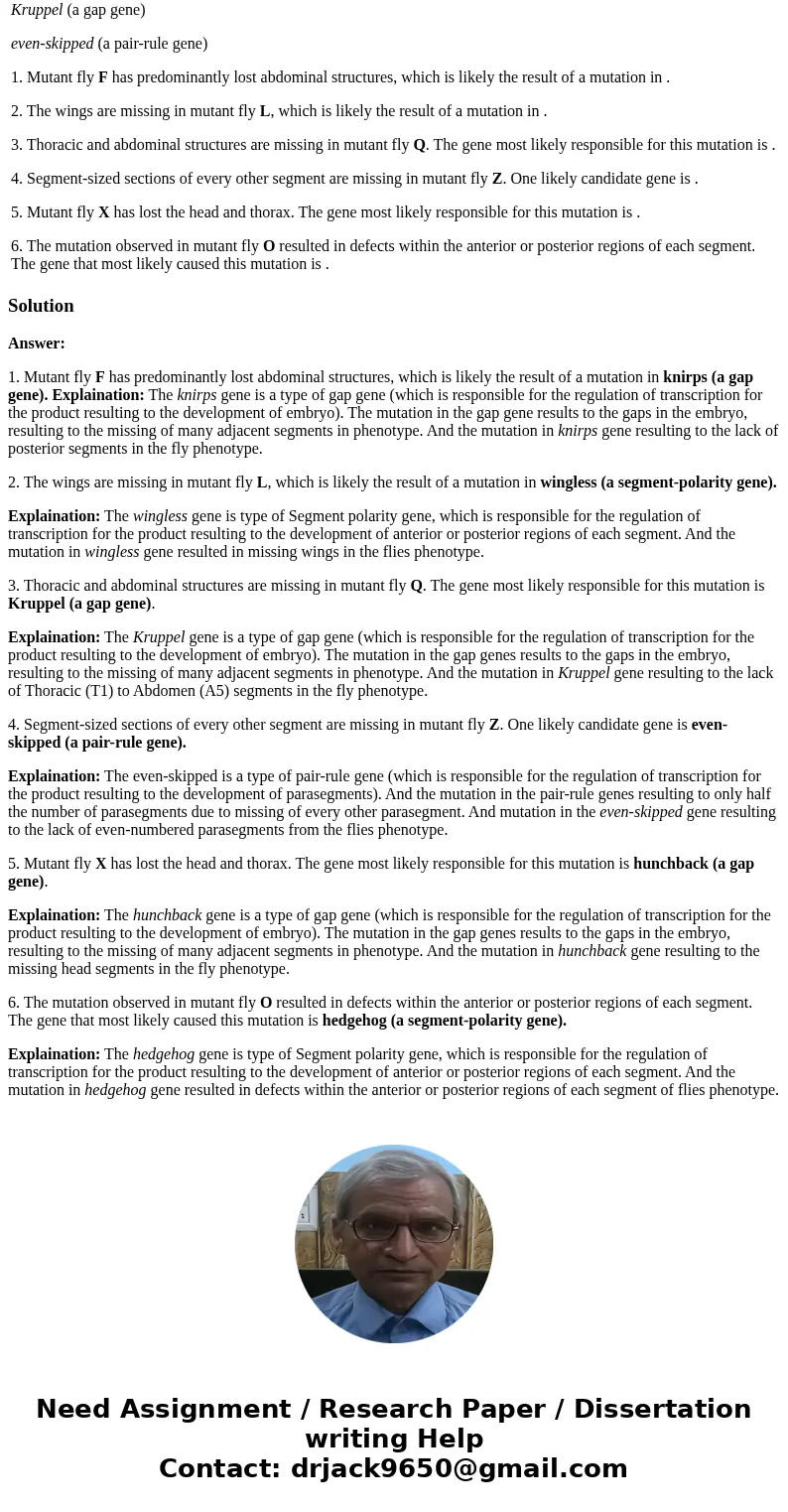Part C You are a graduate student in the lab of a famous fly
Part C
You are a graduate student in the lab of a famous fly geneticist. You need to analyze a batch of mutant flies that were recently created in her laboratory to identify the single gene that is most likely mutated in each of the flies.
Drag the mutations on the left to the appropriate blanks on the right to complete the sentences.
Help
Reset
knirps (a gap gene)
hunchback (a gap gene)
hedgehog (a segment-polarity gene)
wingless (a segment-polarity gene)
Kruppel (a gap gene)
even-skipped (a pair-rule gene)
1. Mutant fly F has predominantly lost abdominal structures, which is likely the result of a mutation in .
2. The wings are missing in mutant fly L, which is likely the result of a mutation in .
3. Thoracic and abdominal structures are missing in mutant fly Q. The gene most likely responsible for this mutation is .
4. Segment-sized sections of every other segment are missing in mutant fly Z. One likely candidate gene is .
5. Mutant fly X has lost the head and thorax. The gene most likely responsible for this mutation is .
6. The mutation observed in mutant fly O resulted in defects within the anterior or posterior regions of each segment. The gene that most likely caused this mutation is .
| Help Reset knirps (a gap gene) hunchback (a gap gene) hedgehog (a segment-polarity gene) wingless (a segment-polarity gene) Kruppel (a gap gene) even-skipped (a pair-rule gene) 1. Mutant fly F has predominantly lost abdominal structures, which is likely the result of a mutation in . 2. The wings are missing in mutant fly L, which is likely the result of a mutation in . 3. Thoracic and abdominal structures are missing in mutant fly Q. The gene most likely responsible for this mutation is . 4. Segment-sized sections of every other segment are missing in mutant fly Z. One likely candidate gene is . 5. Mutant fly X has lost the head and thorax. The gene most likely responsible for this mutation is . 6. The mutation observed in mutant fly O resulted in defects within the anterior or posterior regions of each segment. The gene that most likely caused this mutation is . |
Solution
Answer:
1. Mutant fly F has predominantly lost abdominal structures, which is likely the result of a mutation in knirps (a gap gene). Explaination: The knirps gene is a type of gap gene (which is responsible for the regulation of transcription for the product resulting to the development of embryo). The mutation in the gap gene results to the gaps in the embryo, resulting to the missing of many adjacent segments in phenotype. And the mutation in knirps gene resulting to the lack of posterior segments in the fly phenotype.
2. The wings are missing in mutant fly L, which is likely the result of a mutation in wingless (a segment-polarity gene).
Explaination: The wingless gene is type of Segment polarity gene, which is responsible for the regulation of transcription for the product resulting to the development of anterior or posterior regions of each segment. And the mutation in wingless gene resulted in missing wings in the flies phenotype.
3. Thoracic and abdominal structures are missing in mutant fly Q. The gene most likely responsible for this mutation is Kruppel (a gap gene).
Explaination: The Kruppel gene is a type of gap gene (which is responsible for the regulation of transcription for the product resulting to the development of embryo). The mutation in the gap genes results to the gaps in the embryo, resulting to the missing of many adjacent segments in phenotype. And the mutation in Kruppel gene resulting to the lack of Thoracic (T1) to Abdomen (A5) segments in the fly phenotype.
4. Segment-sized sections of every other segment are missing in mutant fly Z. One likely candidate gene is even-skipped (a pair-rule gene).
Explaination: The even-skipped is a type of pair-rule gene (which is responsible for the regulation of transcription for the product resulting to the development of parasegments). And the mutation in the pair-rule genes resulting to only half the number of parasegments due to missing of every other parasegment. And mutation in the even-skipped gene resulting to the lack of even-numbered parasegments from the flies phenotype.
5. Mutant fly X has lost the head and thorax. The gene most likely responsible for this mutation is hunchback (a gap gene).
Explaination: The hunchback gene is a type of gap gene (which is responsible for the regulation of transcription for the product resulting to the development of embryo). The mutation in the gap genes results to the gaps in the embryo, resulting to the missing of many adjacent segments in phenotype. And the mutation in hunchback gene resulting to the missing head segments in the fly phenotype.
6. The mutation observed in mutant fly O resulted in defects within the anterior or posterior regions of each segment. The gene that most likely caused this mutation is hedgehog (a segment-polarity gene).
Explaination: The hedgehog gene is type of Segment polarity gene, which is responsible for the regulation of transcription for the product resulting to the development of anterior or posterior regions of each segment. And the mutation in hedgehog gene resulted in defects within the anterior or posterior regions of each segment of flies phenotype.


 Homework Sourse
Homework Sourse